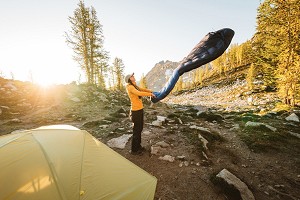
Because science is yet to better the insulating properties of goose down, design improvements have been evolutionary rather than revolutionary. A good bag bought ten or even twenty years ago is not very different from a good bag bought now. Sea to Summit (S2S), an Australian company started by the mountaineer Tim McCartney-Snape, have obviously put a huge amount of thought, research and design into coming up with something a little different. With the Alpine range bags they have combined natural and synthetic insulation to exploit the advantages of both. What they have a produced is a bag that isn't significantly lighter or warmer than its competitor models, but a bag that will keep those properties over longer periods of use than the competition.
"...We all sweat even when sleeping, some sources claim the body can produce a pint a night, which, if correct, is a really disgusting thought..."
Most know that down bags give far superior warmth to weight than synthetic-filled bags, but on the other hand, down loses its insulation value quickly as it get damp whilst synthetic insulations resist damp much better. Various methods have been used over the years to protect down bags from moisture – most often some sort of water resistant material for the outer shell, but this doesn't address the issue of moisture from the inside – sweat.
We all sweat even when sleeping, some sources claim the body can produce a pint a night, which, if correct, is a really disgusting thought. Sweat leaves the body as water vapour but will condense on the outer, cooler insulation of the bag where the dew-point is met. Particularly after multiple days of use, perspiration will progressively degrade a sleeping bags insulation, and in certain conditions it can happen quite quickly: what some call 'sleeping bag collapse'. Drying out down bags is a must on expeditions and longer trips. This is why most have black insides; they can be turned inside out and put on top of the tent when the sun comes out. But the sun doesn't always come out, or you might simply not have time to air the bag, in which case you have to expect the bag's performance to drop a little each night.
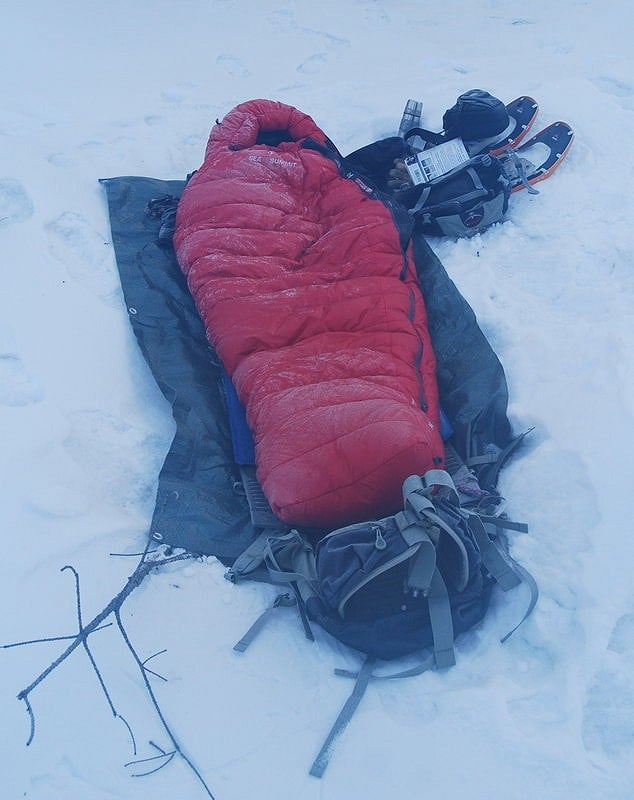
A few hardy types, often arctic travelers, use vapour barrier liners (VBL) to protect their sleeping bags. VBLs are non-breathable liners; they keep the sweat in, so the insulation of the main bag remains dry. Not only are they an extra thing to carry, you end up wet from your own sweat. I've only tried VB socks and didn't like the experience, so the idea of sleeping in my own sweat is not appealing. With their Alpine range, S2S's solution to keep the insulation dry avoids this. Water vapour passing through the down doesn't just exit the outer shell of the bag because of what is called the dew point – the point where vapour condenses on a cold surface.
In a sleeping bag, this will be the down near the outer shell. What S2S have done with what they call the '3D Nano Shell' is, in effect, wrapped their top quality down bag in a very thin synthetic bag (this is the '3D' bit) and, thus, moved the dew point out into the synthetic insulation. The water vapour will condense there, rather than on the more delicate down. Add the 'Nano shell', which seems to be a very efficient DWR treatment, to the outer shell and you also have good protection for the down from dampness on the outside.
The physics behind this make sense, although I'd be interested to know how they work out the thickness of synthetic insulation needed to ensure that the dew point is in it, rather than the down – the synthetic layer is small proportion of the bags overall thickness. We had a hard winter in Finland this year but unfortunately the bag for testing only arrived in its waning weeks. I used it on consecutive nights in sub-zero temperatures and it seemed consistently warm, but then the temperatures were not as cold as the bag's lower limit of –15, so it is hard to say how much this is the 3D Nano Shell technology and how much it is that it is just a very well made and designed down bag. The concept seems to work, but this is obviously the part of the design of the bag that S2S are particularly proud of, so I will report back next autumn or winter once I have had chance to use it on multiple, consecutive nights at colder temperatures.
I can though attest that I found the bag comfortable for one night at its lower limit of –15. I was bivvying without either a bivvy bag or a tarp – just the bag between me and the frosty air. In the morning everything was covered in a thick frost (to the extent that my main camera failed because on taking the lens cap off the lens immediately was covered in a layer of frost that refused to sublimate away) but the shell of the bag dealt with it with no problem. Once brave enough to get up, most of the ice simply shook off the bag. I woke once very early in the morning with cold thighs, but this may have been to do with how I was sleeping, as after rubbing them and kicking my leg around a bit to improve the circulation and I slept the rest of night through with no other disturbances.
"...What S2S have done is wrap their top quality down bag in a very thin synthetic bag and thus moved the dew point out into the synthetic insulation..."
My wife, who feels the cold much more than I do – as is typical for women – has also used the bag on a night where it was cold enough for the open leads to refreeze on the still mainly icy sea next to our campsite. The bag's 'comfort rating', which provides a limit for women, is -9 degrees. She reports that it was great until the early morning when our five year-old decided Mummy's bag looked a better bet than his, and decided to get in with her. The bag is a comfortable fit for one adult, but less so with an additional small squirming child!
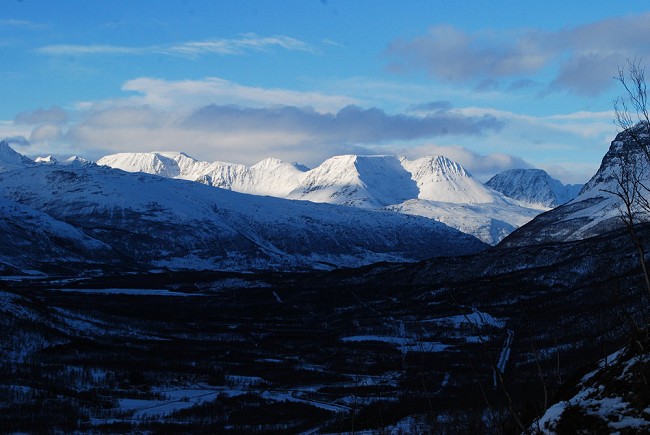
To get this warmth, along with the 3D Nano shell, S2S uses 850+ loft goose down. This is virtually as good as down gets, and each bag comes with a certificate from the independent International Down Feather Laboratory (IDFL) confirming the down quality – a nice touch. To get an idea of what the down quality means, the Alpine II has a fill weight of 710 grams get a –15 rating. Bags with a similar rating but lower quality down tend to have a fill weight around a kilo, and hence have a total weight higher than the Alpine II's 1290 grams.
There are lighter bags available for -15, but the Alpine II is designed to keep working well, night after night. Additionally, S2S also use different 'differential cuts' on the top and base of the bag, along with offset baffles – all clever ways to maximize the down's ability to loft and best understood in the diagrams on S2S website (http://www.seatosummit.com.au/sleepingbags/construction.php). The hood and draft collar are also very well designed and work perfectly in my experience.
Finally, S2S have added a few little things that you come to really appreciate. There is an internal pocket – as we progressively take more electronic devices into the hills, keeping them, or their batteries, warm is important. The non-snag material alongside the zip, is simply superb. Supposedly this stuff was originally used in sails for racing yachts, but the strips either side of the zip make snagging a thing of the past. The Alpine II also comes with three storage bags – a high quality, light compression sack for in the field, a large cotton bag for use if you wash the bag, and a very nice rectangular storage 'box-bag', which slides into cupboards more easily than the normal round sack. The thought involved in these little things is indicative of the overall quality of the Alpine II bag.
Conclusion:
All good winter bags – that offer real warmth in the minus teens without being very heavy and bulky – cost a lot of money. Top quality down is expensive, and the sewing construction needed to get the most out of it is complex. But the S2S Alpine II is expensive compared to even similar bags – can that cost be justified? For the occasional user who might once a year spend a single, cold, Scottish highland night out at –10 or even colder, in truth probably not; just wear more in bed! But if you spend numerous nights out each year in such temperatures, then the case will be different. With the –15 rating, most potential buyers will probably be going beyond of the UK. If your dream trip is winter ski-backpack through the Sarek national park in Arctic Sweden, a long trek in the winter Himalayas, or something similar where having a bag that doesn't perform night after night could spoil that dream, then the extra cost for this superbly designed and made sleeping bag may well become justifiable.
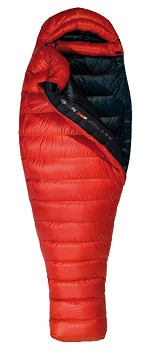
Sea To Summit Alpine II Sleeping Bag
- Contoured mummy, 3D NanoShell
- Differential cut shell with 3D side walls
- Offset baffles
- 60/40 fill ratio
- Side block baffle
- Anatomically tapered box foot
- Zip draft tube with anti-snag
- Neck draft tube with dual elastic adjustment
- Cushioned internal hood drawcord with dual adjustment
- 2 way YKK #5 side zip
- Medium sized internal zip pocket
- Includes lightweight Ultra-Sil compression bag, mesh storage cell and laundry bag
- Comfort: -9; Lower limit: -15; -35 Extreme
- Down: 850+ Loft 95% European Goose Down
- Fill weight: Regular 710 g/25 oz | Long 780 g/28 oz
- Bag weight: Regular 1290 g/2 lb 14 oz | Long 1450 g/3 lb 3 oz
- Length / zip options: Regular - left zip | Long - left zip
- Season ratings: Autumn/Winter
- Suggested use: Winter trekking, Snow camping, Ski touring, Alpine climbing, Expeditions
- Compression bag: Large - 20L to 8.3L
About Toby Archer
Toby Archer is based in Finland.He describes himself as an "international politics think-tanker, perennial PhD student, hopeless but enthusiastic climber, part-time gear reviewer, often angry cyclist, idealist, cynic."
Climbing keeps him from getting too depressed about politics. He blogs about both at:
Light from the North - chilled thoughts from the top of Europe.

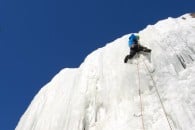

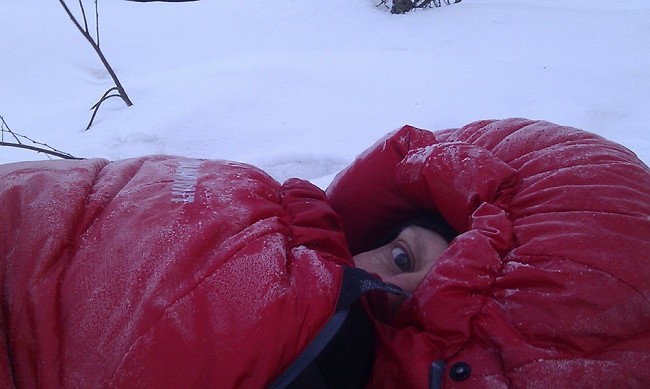
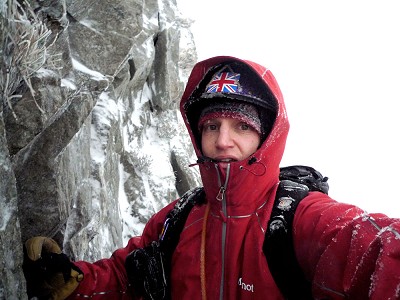

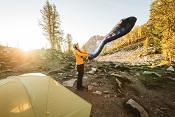
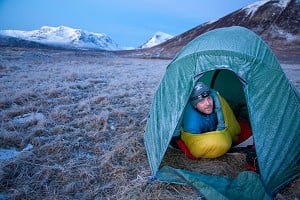
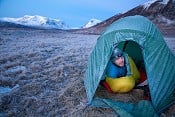
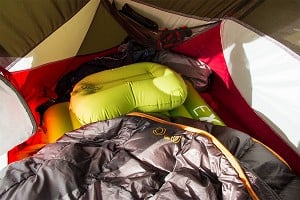
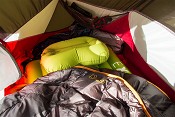
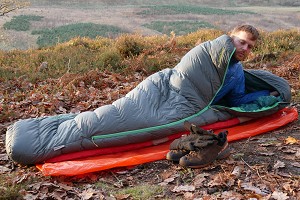
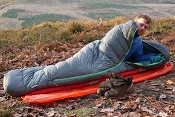
Comments